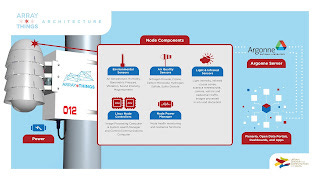'Array of Things' collects facial biometrics and license plates images (Updated)

image credit: Arrayofthings
Argonne Labs and DHS are installing over 500 spying devices called the 'Array of Things' (AoT) throughout Chicago and plan to install them in cities across the country. Plans are in the works to replicate the project in the coming years in more than a dozen other cities.
Two cameras mounted in each AoT box will collect data on vehicle and foot traffic, standing water, sky color and cloud cover. They claim the photos taken by the cameras will automatically be deleted within "tens of minutes."
Should we trust them?
The AoT bears a striking similarity to 'Visual Analytics for Command, Control and Interoperability Environments' which turned CCTV cameras into surveillance devices.
Please, read my four part series where I explain, how the government turned public and private CCTV cameras into a nationwide surveillance system.
Feds admit they'll use the internet of things to spy on everyone
US intelligence chief James Clapper warns...
“In the future, intelligence services might use the [internet of things] for identification, surveillance, monitoring, location tracking, and targeting for recruitment, or to gain access to networks or user credentials,” Clapper said.
Back in 2012, former CIA director David Petraeus called the surveillance implications of the internet of things “transformational … particularly to their effect on clandestine tradecraft”.
Petraeus said, the CIA and our Intelligence Community partners must be able to swim in the ocean of “Big Data.” Indeed, we must be world class swimmers—the best, in fact.
Earlier this year, I warned everyone that cities and towns are also being equipped with spying Bluetooth detectors, that are able to identify pedestrians and motorists.
By combining a license plate or a phone number with a Bluetooth serial number, it’s possible to track citizens via their phone warns, technology entrepreneur Michael Robertson.
Updated 10/11:
Wi-Fi can be used to identify people in IoT locations
Wi-Fi signals can be used to unobtrusively identify different people at a location, such as home. Channel State Information a form of waveform analysis, promises to replace other forms of identification.
Channel State Information, describes how the signal propagates from the transmitter to the receiver and reflects the combined effects of the surrounding objects... We implemented the system in a 6m*5m smart home environment and recruited 9 users for data collection and evaluation. Experimental results indicate that the identification accuracy is about 88.9% to 94.5% when the candidate user set changes from 6 to 2, showing that the proposed human identification method is effective in domestic environments.
AoT collects, facial images and license plate info.
The only data that will not already be public is a limited set of images used to improve computer vision software. These images will contain no sensitive PII, but some may show faces or license plate numbers. The University of Chicago, as copyright holder of the data, would be responsible for responding to law enforcement requests.
Below is an excerpt taken from page 7 of Argonne Labs, AoT operating policy.
Personally Identifiable Information or PII is any information about an individual, including “(1) any information that can be used to distinguish or trace an individual’s identify, such as name, social security number, date and place of birth, mother’s maiden name, or biometric records; and (2) any other information that is linked or linkable to an individual, such as medical, educational, financial, and employment information.” As noted in NIST 800-122, this includes the following:
•Personal identification numbers
•Email or street address information
•Information about an individual that is linked or linkable to one of the above (e.g., date of birth, place of birth, race, religion, weight, activities, geographical indicators, employment information, medical information, education information, financial information)
Police and banks have access to AoT data
The University of Chicago is the copyright holder of all the data AoT collects. According to the university's 1007 privacy policy, government agencies like the police, FBI and DHS will have access to AoT data.
All inquiries from other government entities and outside agencies regarding University employees or others seeking confidential information must be immediately referred to the Human Resources for response or reference to the appropriate administrative office. Such entities and agencies include, but are not limited to:
government entities such as the FBI, Social Security Administration, Illinois Department of Employment Services (IDES), Equal Employment Opportunity Commission (EEOC), Illinois Department of Human Rights (IDHR), National Labor Relations Board (NLRB), Department of Health and Human Services (DHHS), Office of Civil Rights (OCR);
credit bureaus, lending entities (e.g., banks, mortgage companies).
America is being transformed into a giant surveillance state, where soon every city and town will be equipped with spying CCTV cameras, Bluetooth detectors and AoT devices.


